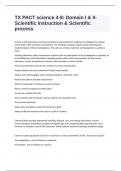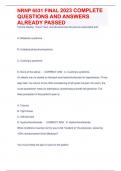TX PACT science 4-8: Domain I & II-
Scientific Instruction & Scientific
process
Science in the elementary classroom provides an opportunity for students to investigate the natural
world, both in the classroom and outdoors. The methods of inquiry require proper planning and
implementation of these investigations. The safe use of tools, materials, and equipment is a primary
focus.
Teaching laboratory safety standards to students prior to participation in any investigation is required, as
is providing them with information regarding proper safety rules and procedures for the science
classroom. correct answersSome common safety practices to teach include:
Never put chemicals back into the container to avoid contamination
Properly dispose of excess chemicals in liquid waste bottles.
Always wear safety goggles when working with glass, chemicals, or fire
Wash hands before and after experiments
Direct the openings of containers away from faces
Never use/touch chipped or broken glass
Do not eat or drink in the lab
Never directly smell chemicals; instead, waft the air toward the face
Do not taste chemicals
Keep water and objects away from electrical outlets
Always notify the teacher in the case of a spill or accident.
Chemical labels provide appropriate handling, disposal, care, and storage procedures. correct
answersTeachers should keep a physical or digital copy of the Material Safety Data Sheet for each
chemical or substance used in the classroom. Safety symbols and their meanings should be taught.
Common safety equipment to have in a classroom: correct answersFirst aid kit - treat minor injuries
Fire extinguisher - put out flames on materials
Fire blanket - put out flames on a person
,Goggles - protect eyes when using glassware or chemicals
Fume hood - pulls chemical gasses up and away from people
Body shower / Safety shower - wash chemical spills off a person
Eyewash station - wash chemicals out of a person's eye
Labeling Samples
It is best practice to label all chemicals as follows: correct answers1. The compound name, written out in
words
2. Who made the sample
3. The date the sample was made
Hazards associated with the material
Proper Handling of Specimens correct answersWhen caring for and handling specimens and organisms,
students should follow ethical and safety procedures and handle animals only when necessary.
Classroom animals must meet safety requirements such as not being toxic or causing a danger to
students. Classroom pet cages should be cleaned regularly with household bleach. Teachers should
check for any students having allergies before choosing a classroom pet.
Students should be taught to wash hands before and after any activity involving plants, animals, or soil.
All microorganisms should be treated as pathogens. Disposal of non-carcinogenic or non-corrosive
contaminants should be in a double-layered plastic bag and fastened securely with a wire tie.
Proper Tool Use
Students should choose the appropriate equipment to use in instructional activities.
Some examples of appropriate equipment include: correct answersa beaker, graduated cylinder, pipette,
or Erlenmeyer flask to measure volume
a metric ruler, meter stick, or metric tape measure to measure length
a balance to measure mass
a scale to measure weight
a Celsius thermometer to measure temperature
a stopwatch to measure time
a computer to record data digitally
,teachers and students should understand that the use of a tool unsuitable to the task or improper tool
use can cause inaccurate readings and corrupt data. For example, it is more accurate to use a graduated
cylinder and water to take the volume of an irregularly-shaped object, rather than using a metric ruler to
measure each dimension. Students should know the proper names and uses of laboratory tools,
materials, and equipment including goggles, hand lenses, balances, magnets, timing devices, weather
instruments, thermometers, rulers, beakers, spring scales, hot plate, test tubes, meter sticks, compasses,
and microscopes. correct answersMany tools need to be handled carefully to avoid damage. For
example, microscopes should always be carried with two hands, with one hand on the base on one hand
on the neck.
Material Safety Data Sheet (MSDS) correct answersa standardized information sheet for a substance;
includes information about health risks, safe disposal and cleanup of spills, and environmental risks
Waft correct answersWave the air toward the face. The safe way to smell a test tube.
When students are conducting an experiment or investigation using glassware, which of the following is
the most important piece of safety equipment for them to use? correct answersGoggles would be the
most important piece of safety equipment because of the potential for glass breaking and hurting the
students' eyes.
When examining the color and clarity of 1 gram of sugar in 30 milliliters of water, which of the following
would be the best substitute for a test tube? correct answersGraduated cylinders tend to be narrower
than beakers and designed for accurately measuring small amounts of liquid.
When is the best time to teach lab safety rules? correct answersimmediately before the students begin
an experiment- Reminding students immediately before they begin using equipment is the best time
because they can better remember and apply the specific safety rules to the specific equipment used
during the experiment.
Which of the following is a safe laboratory procedure? correct answersFume hoods are designed to
increase airflow to remove fumes and protect any lab occupant from inhaling them. Volatile compounds
are those that have a high vapor pressure at room temperature, which leads to their evaporation or
sublimation into the gas phase. Many volatile compounds are quite toxic and can produce long-lasting
health effects.
, Which of the following would best help students learn to protect themselves against potential health
hazards in the laboratory? correct answersRegularly require students to wash their hands after a lab
experience.
Requiring hand washing after touching equipment can lead to good safety habits for all students.
Mr. Orlando is teaching a unit about density, which is the amount of mass in a given volume. He would
like students to practice measuring the density of various objects. Which of the following lists of
equipment should Mr. Orlando provide to his students? correct answersa graduated cylinder and a
balance
Density is the relationship between the mass of a substance and its volume. A graduated cylinder will
help the student measure volume and a balance will help the student measure mass.
Mr. Orlando is on the far side of the room when he sees a student mishandling equipment during a
laboratory activity. Which of the following is the best first step Mr. Orlando should take to resolve the
problem? correct answersUsing proximity, or moving close to a misbehaving student, is an excellent first
step. It does not escalate the issue, but lets the student know you see what he or she is doing and that it
is inappropriate. Often the student will then self-monitor. The next steps might involve quietly correcting
the student and talking with the student individually during recess.
Which of the following is the responsibility of the teacher with regard to the use of chemicals? correct
answersknowing the chemicals used in each laboratory experiment and reviewing the material safety
data sheet for them
The teacher is responsible for knowing the substances and reviewing the safety guidelines.
Which of the following are appropriate lab safety standards?
Select all answers that apply. correct answersstudents should wear safety goggles when working with a
flame.
Safety goggles are recommended whenever students work in the lab, especially when working with heat,
glassware, or chemicals. Regular prescription glasses and sunglasses are not sufficient.
A first aid kit should be kept in the classroom.
A first aid kit should be available in the classroom to treat minor injuries.
eye wash should be for about 15-20 mins





